#history of the bathing suit
Explore tagged Tumblr posts
Text

"Two Beauties-Striped Bass," Border Cities Star. April 10, 1934. Page 17. --- 0RGANIZATIONS interested in the annual striped bass carnival at McNear's Beach, Marin County, Calif., must figure that even "stripers," generally chary of human companionship at the end of a fishing line, are looking forward to the event, for they are staging a fishermaid contest. Here are two of the entries, who have been preparing for the event, Miss Marie Regalia, left, and Miss Jean Bucknum.
#marin county#fishing#gone fishing#going to the beach#swimming#summer at the beach#beachgoers#bathing suit#history of the bathing suit#history of bathing suits#evolution of the swimswuit#swimsuits#any excuse to show beautiful women#any excuse to show women in swimsuits#the great depression
0 notes
Text



• Bathing Suit.
Brand: Catalina
Date : 1955-1958
Medium: Synthetic, glass, metal, elastic, cotton
#fashion history#history of fashion#fashion#vintage clothing#vintage fashion#vintage#bathing suit#catalina#1955#1958#1950's fashion#1950's
443 notes
·
View notes
Text
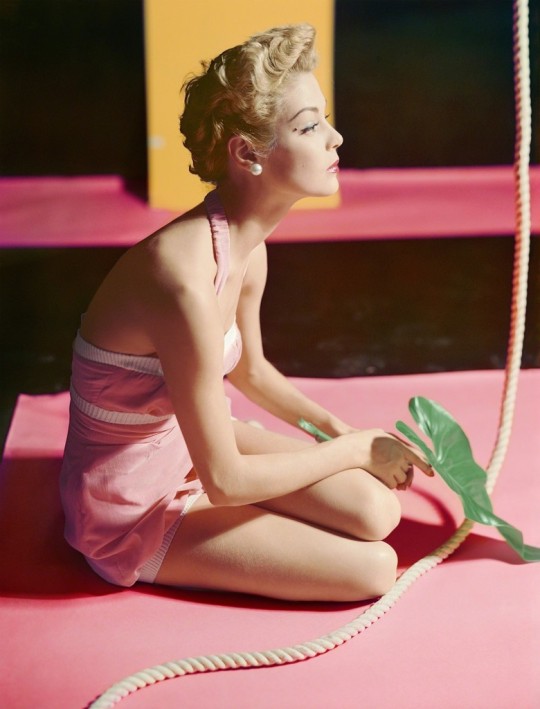
Photographer: Horst P. Horst
Fashion in Colour- Jean Patchett, Bathing Suit by Brigance, 1954
#Horst P. Horst#art#fashion#photography#pink#bathing suit#1950s#Jean Patchett#fashion history#fashion photography
157 notes
·
View notes
Text
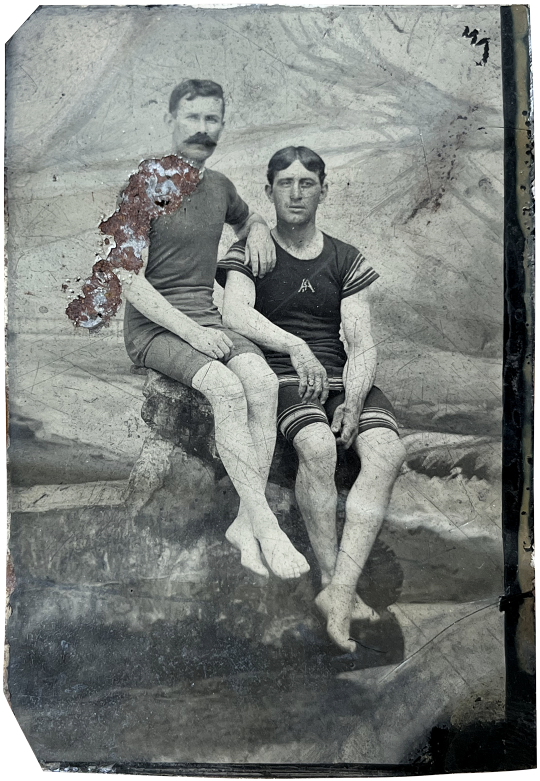
Tintype of a handsome pair posing together in their bathing suits, c. 1890s. You can't tell on screen, but in person it's evident that the fingerprint on the lower right corner is actually indented into the emulsion. One of these guys, or perhaps the photographer, must've grown impatient and picked up the picture before it was quite ready—on some summer day over a hundred years ago.
#this is the objectively worst-condition item in my collection—it’s bent! and scratched! AND rusted!—but somehow it’s got charm#sort of like how 19th century bathing suits are so goofy they loop back around to an unlikely allure#19th century#1800s#1890s#19th century fashion#men's fashion#swimsuit#fashion history#historical fashion#19th century photography#ferrotype#tintype#gay interest
219 notes
·
View notes
Text


Black And White Bathing Shoes, 1910-19
#20th century#edwardian#1910s#shoes#bathing shoes#bathing suit#fashion history#black#white#youngpyromaniac
27 notes
·
View notes
Photo
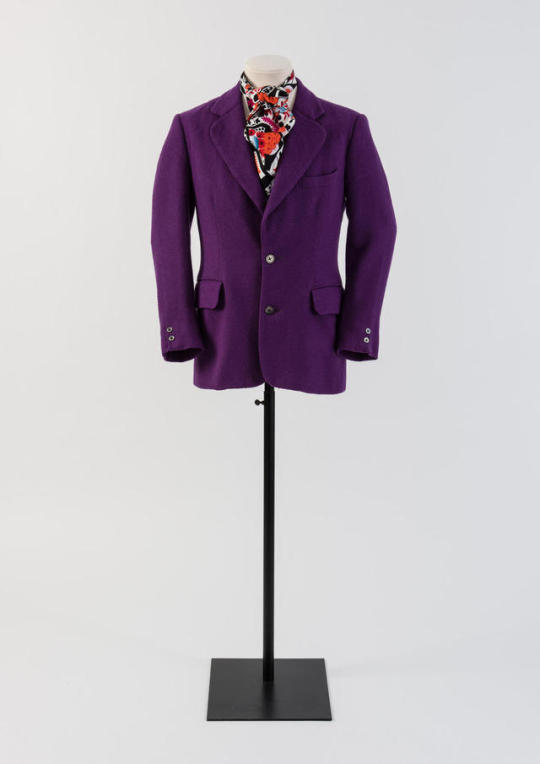
Suit Jacket
Mr. Fish
1968
Fashion Museum Bath
#suit jacket#fashion history#1960s#vintage fashion#menswear#mensfashion#1968#20th century#purple#british#united kingdom#fashion museum bath
228 notes
·
View notes
Text
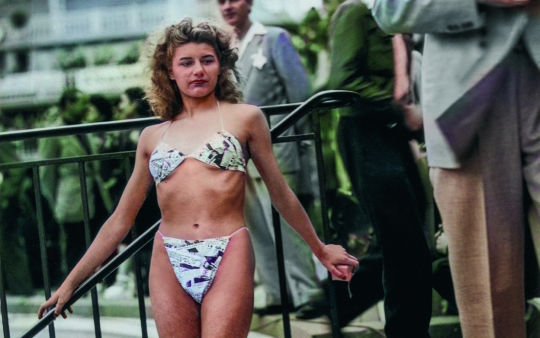
The bikini is the most important thing since the atom bomb.
Diana Vreeland
The origins of contemporary bikini day may be traced back to a French engineer, a Parisian exotic dancer, a nuclear testing site in the United States, and a postwar fabric shortage.
In 1946, Western Europeans joyously greeted the first war-free summer in years, and French designers came up with fashions to match the liberated mood of the people. Two French designers, Jacques Heim and Louis Réard, developed competing prototypes of the bikini. Heim called his the “atom” and advertised it as “the world’s smallest bathing suit.”
French fashion designer Louis Reard was determined to create an even more scandalous swimsuit. Réard's swimsuit, which was basically a bra top and two inverted triangles of cloth connected by string, was in fact significantly smaller. Made out of a scant 30 inches of fabric, Réard promoted his creation as “smaller than the world’s smallest bathing suit.”
Réard claimed that the bikini was named for Bikini Atoll, the site of nuclear tests by the United States in the Pacific Ocean.
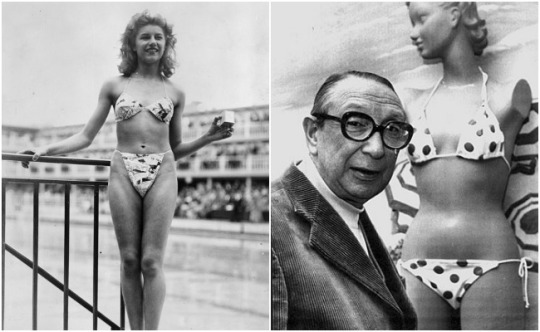
Louis Réard's bikini was so little that he couldn't find anyone brave enough to wear it. After being rejected by a number of fashion models, he came across Micheline Bernardini. She was a 19-year-old nudist at the Casino de Paris who consented to be the first to try on his daring bikini. Michelle Bernardini debuted this revealing costume at the Piscine Molitor in Paris during a poolside fashion show, and it revolutionised swimwear on 5 July 1946. The bikini was a hit, especially among men, and Bernardini received some 50,000 fan letters.
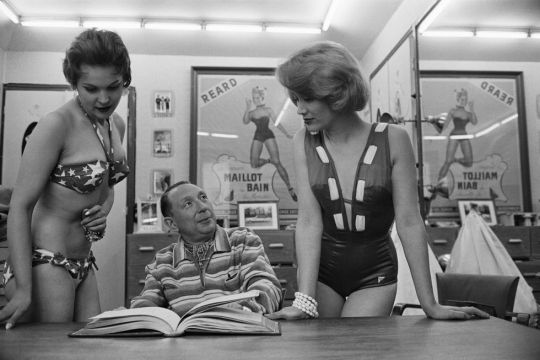
Before long, bold young women in bikinis were causing a sensation along the Mediterranean coast. Spain and Italy passed measures prohibiting bikinis on public beaches but later capitulated to the changing times when the swimsuit grew into a mainstay of European beaches in the 1950s. Réard's business soared, and in advertisements he kept the bikini mystique alive by declaring that a two-piece suit wasn’t a genuine bikini “unless it could be pulled through a wedding ring.”
But it really took when what we would call cultural influencers took to it. It was in 1953, thanks to Brigitte Bardot, that the bikini became a "must-have" and the history of the bikini became historic, when she was photographed wearing one on the Carlton beach at the Cannes Film Festival. She also wore one in 1956, in the film "Et Dieu… créa la femme".
The United States also caught on to the trend, as it was only two years later that Ursula Andress posed in a white bikini on the poster for the James Bond film, Dr. No. The poster created a considerable marketing coup, and women adopted the bikini. According to a study by Time, 65% of younger women adopted the bikini in 1967.
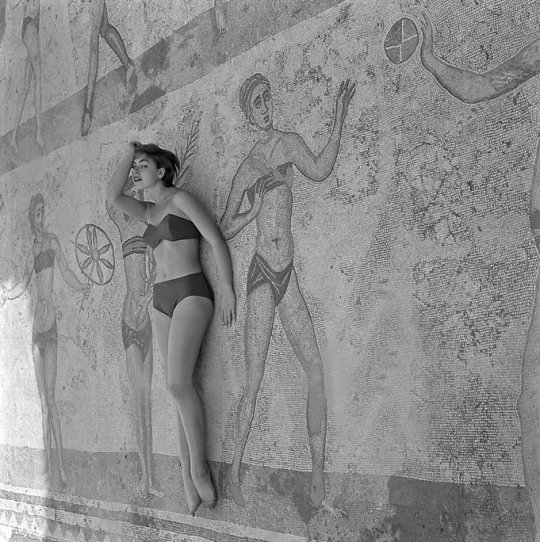
There is no question the bikini is hardly modern. Many think they date back to ancient Roman times because of the murals uncovered in excavated ruins in Sicily. This isn’t really true.
Despite the celebrated images from the mosaics in Piazza Armerina, of the ancient Roman girl wearing what looks like a bikini, the answer is, “not really”. The ancient Roman girls weren’t even first to wear what to our eyes looks like a bikini. However, the fact that we seem to find “bikinis” in ancient depictions should make us rethink our hubristic bias that we in modern times have invented everything and that people in ancient times didn’t know how to live.
Archaeologists have found evidence of bikini-like garments that date to as far back as 5600 BC. That’s roughly 5000 years before the Romans did so. In the Chalcolithic era of around 5600 BC, the mother-goddess of Çatalhöyük, a large ancient settlement in southern Anatolia, was depicted astride two leopards while wearing a bikini-like costume.
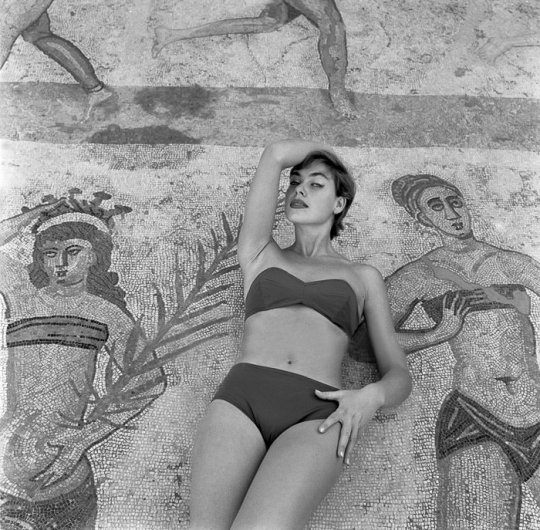
Two-piece garments worn by women for athletic purposes are depicted on Greek urns and paintings dating back to 1400 BC. In fact, even just the notion that women participated in sports in the ancient world should make us sit up and take notice.
Today we tend to imagine women in the ancient world as being practically sequestered in their homes, spinning, weaving and having babies. But this is a gross oversimplification of their role.
Active women of ancient Greece wore a breast band called a mastodeton or an apodesmos, which continued to be used as an undergarment in the Middle Ages. While men in ancient Greece abandoned the perizoma, partly high-cut briefs and partly loincloth, women performers and acrobats continued to wear it.
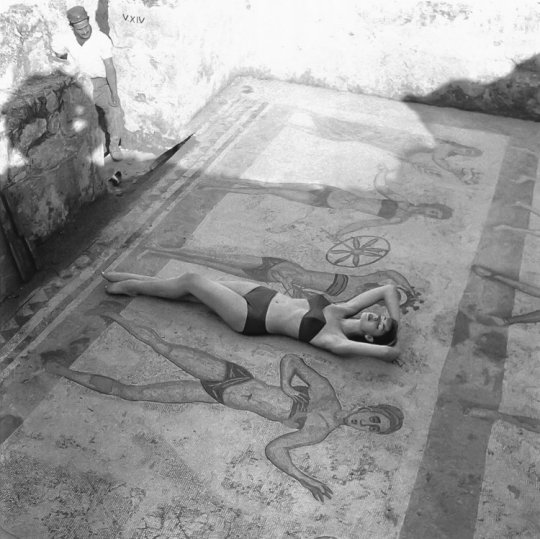
In the famous mosaics to be found at Villa Romana del Casale in Piazza Armerina, the girls who seem to be wearing the “bikini” are Roman and the so-called bikini had already been around for at least 5,000 years by then. In the artwork “Coronation of the Winner” done in floor mosaic in the Chamber of the Ten Maidens (Sala delle Dieci Ragazze) in Sicily the bikini girls are depicted weight-lifting, discus throwing, and running.

The bikini was gradually done away as Christianity became more influential as the centuries wore on. Christian attitudes towards swimming restricted the clothing of women for centuries, the bikini disappeared from the historical record after the Romans until the early 20th century with Louis Beard’s re-invention of the two piece bathing suit as the ‘bikini’.
Photos: In 1956 Emilio Pucci designed this bikini inspired by the mosaics of the Villa Romana Del Casale in Sicily.
#vreeland#diana vreeland#bikini#femme#history#fashion#style#woman#louis reard#bathing suit#beach#ancient rome#ruins#inspiration#ancient world#bikini atoll#atomic bomb#paris#italy#sicily#culture#society
85 notes
·
View notes
Note
Ok first of all, I want to say that I love your goofy little drawings. They always put a smile on my face whenever I see them.
Also I have a drawing request. Could you please draw Victorian England Byler. I would love to see Mike give a bouquet of flowers to Will using Victorian flower language.
Hope you have a good rest of your week!
Ahhh thank you!! This one was actually very, very fun. Mike would love Victorian Flower Language, but he'd do it in the weirdest ways. (I put in a little guide to the plants at the bottom)

Plants in the drawing and their Victorian meaning:
Tussilage- 'Justice shall be done to you'
Burning Nettle- slander
Green Carnation- A secret sign of homosexuality appearing first in the late 1800s, often worn on the front of a coat
Pineapple- 'You are perfect'
Syringa, Carolina- disappointment
Sweet William- Gallantry
Also I need a Victorian AU fic where Mike uses flower language IMMEDIATELY
#victorian byler#byler#stranger things#byler fanart#will byers#mike wheeler#If I had a nickle for every time Mike liked flowers in one of my AUs#I'd have three nickels#Which isn't a lot but it's weird that it happened thrice#Victorian bathing suits are my favorite#I needed a beach holiday for that reason#Silly sock factory#Mike wears silly socks#history with byler
37 notes
·
View notes
Text

#swim team#school pool#bathing suit#male swimmer#male swimwear#swimwear#history#high school#school sports#1952#1950s history#1950s#early 1950s#mid century#department of education#skip hamilton#school boards
6 notes
·
View notes
Photo


Bathing suit
1900–1910
53 notes
·
View notes
Text
Classy in White
White clothes can symbol purity 🪷. White is often associated with purity, perfection, honesty, cleanliness, and beginnings. Many people in Europe and the United States repeatedly link the color white to forms of purity and enchanted bliss. White has a class of simply making a statement of boldness with out trying to hard.

View On WordPress
#4th of July#Accessories For Fashion#Advice Topics#After 5 Style Boards and Subjects#After Party#All Black Style#and Podcasts#Art and Fashion#Art Blogging#At Home Casual#Autumn Fashion Advice#Autumn Style Board#Autumn Wedding Style#Bathing suit#Beach Topics#Beautiful Makeup Topics and Tips#Beauty Care#Birthday Shopping#Black History Month#Black Models#Bold Fashion#Bridesmaid style#Brunch Fashion#Business Coaching#Business Trends and Topics#Celebrity Love#Chanel#Christmas Ball#Christmas Beauty#classy
3 notes
·
View notes
Text

"COUNTERACT HEAT WAVES WITH MORE WAVES," Toronto Star. June 5, 1934. Page 19. --- When these little ladies were almost down and out with the heat waves which have been rolling over the city and district for the past few days, they hied themselves to more waves-but cooler ones on Toronto's eastern beaches. Yesterday the photographer went to Simcoe beach, with the idea of getting pictures and getting cooled off and came back with these four fair damsels, splashing through the breakers. He forgot his bathing suit, so couldn't accept their invitation to get in the swim.
#toronto#summer#going to the beach#swimming#windsor#summer at the beach#beachgoers#bathing suit#history of the bathing suit#history of bathing suits#evolution of the swimswuit#swimsuits#any excuse to show beautiful women#any excuse to show women in swimsuits#great depression in canada#heat wave
0 notes
Text

James Ensor
L’appel de la sirène, 1893
Ensor Foundation, Ostende, Belgium
1 note
·
View note
Text
"I have worn a two-piece Victorian bathing suit, as described in many of the fashion articles from the period, and it was a fantastic experience. I enjoyed not having to bare my midriff, and, while the costume was slightly heavier when wet than a modern swimsuit, it was not so heavy as to be a nuisance or to hinder my movement. It did take longer to dry, which is why I, and perhaps many Victorian women, chose to change out of it relatively quickly. But, as a dry garment, worn before entering the water, it was much more comfortable for the beach, offering protection from the vagaries of the British weather. Made from woven fabric, the costume was easy and comfortable to wear, pleasant to swim in, and it kept its shape, wet or dry. It was, of course, not designed for those who were interested in getting an even tan. The Victorian woman was generally horrified at the idea of any tanning at all. White skin was what a woman aimed for in order to help differentiate her from those who had to work outdoors for a living. And with no such thing as sunblock to protect a person from sunburn, covering up was double sensible."
- How To Be A Victorian, Ruth Goodman, page 365
1 note
·
View note
Text

Tintype of two men in bathing suits facing the sea together, c. 1870s
#it's them against the world and first they're gonna fistfight the fucking ocean#19th century#1800s#1870s#1870s fashion#19th century fashion#fashion history#historical fashion#men's fashion#vintage bathing suit#19th century photography#ferrotype#tintype#19th century men#gay interest
146 notes
·
View notes
Text



Bathing suit, navy wool with white soutache, 1904
1904. Woman’s one-piece bathing suit of navy wool with white soutache trim, closing in front, with short sleeves and short pant legs, and a separate short skirt buttoning to the waist.
10 notes
·
View notes